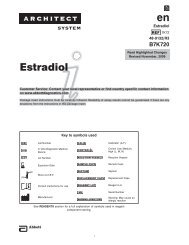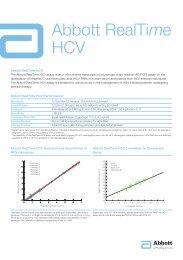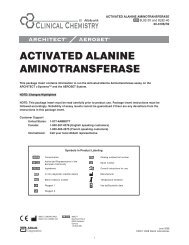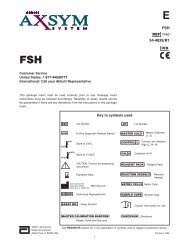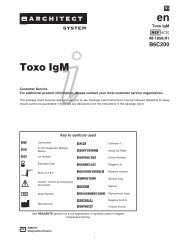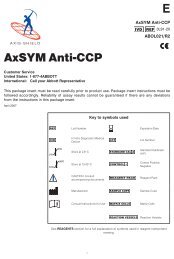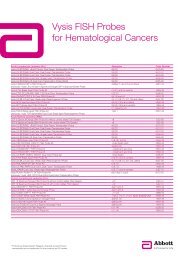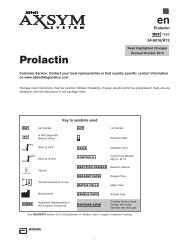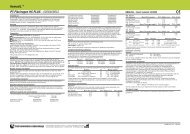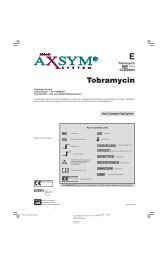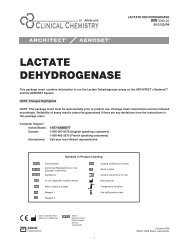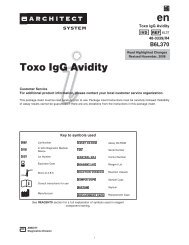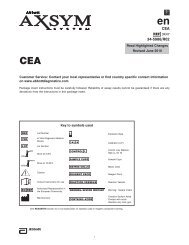ABBOTT PRISM® HTLV-I/HTLV-II - ILEX Medical Systems
ABBOTT PRISM® HTLV-I/HTLV-II - ILEX Medical Systems
ABBOTT PRISM® HTLV-I/HTLV-II - ILEX Medical Systems
Create successful ePaper yourself
Turn your PDF publications into a flip-book with our unique Google optimized e-Paper software.
U. S. Patent No. 4, 380, 580, licensed under patent rights of Bayer Corp. Tarrytown,<br />
New York, USA, relates to this product.<br />
NAME AND INTENDED USE<br />
The <strong>ABBOTT</strong> PRISM ® <strong>HTLV</strong>-I/<strong>HTLV</strong>-<strong>II</strong> assay is an in vitro chemiluminescent<br />
immunoassay (ChLIA) for the qualitative detection of antibodies to human<br />
T-lymphotropic virus type I and/or human T-lymphotropic virus type <strong>II</strong> (anti-<strong>HTLV</strong>-I/<br />
<strong>HTLV</strong>-<strong>II</strong>) in human serum or plasma. The <strong>ABBOTT</strong> PRISM <strong>HTLV</strong>-I/<strong>HTLV</strong>-<strong>II</strong> ChLIA<br />
is intended as a screen for donated blood to prevent transmission of <strong>HTLV</strong>-I and<br />
<strong>HTLV</strong>-<strong>II</strong> to recipients of blood and blood components and as an aid in the diagnosis<br />
of <strong>HTLV</strong>-I and <strong>HTLV</strong>-<strong>II</strong> infections.<br />
SUMMARY AND EXPLANATION OF THE TEST<br />
<strong>HTLV</strong>-I, a human Type-C retrovirus, 1,2 has been etiologically associated with<br />
neoplastic conditions and a variety of demyelinating neurologic disorders including:<br />
adult T-cell leukemia (ATL), 3 tropical spastic paraparesis (TSP) 4,5 and/or <strong>HTLV</strong>-I<br />
associated myelopathy (HAM) 6 and more recently <strong>HTLV</strong>-I associated polymyositis,<br />
arthritis and infective dermatitis. 7-9 Antibodies to <strong>HTLV</strong>-I are found with high<br />
frequency in persons afflicted with these disorders. However, it is well established<br />
in studies from viral endemic areas that <strong>HTLV</strong>-I antibody negative ATL and TSP/HAM<br />
are seen. 10-12<br />
<strong>HTLV</strong>-I infection is endemic in the Caribbean, 11 south-eastern Japan, 12 in some<br />
areas of Africa, 13 Central and South America, 14 and recently described in<br />
Melanesia 15,16 and central and northern Australia. 17,18 In the United States, <strong>HTLV</strong>-I<br />
has been identified in ATL patients, intravenous drug users and in healthy<br />
individuals. 19-23 Transmission of <strong>HTLV</strong>-I (and <strong>HTLV</strong>-<strong>II</strong>) infection to transfusion<br />
recipients of infected cellular blood products is well documented. 24-29 Transmission<br />
also occurs via breast milk, 30 sexual contact, 31,32 and sharing of contaminated<br />
needles and syringes by intravenous drug users. 20,23,33<br />
<strong>HTLV</strong>-I causes ATL in only 2 to 4% of infected individuals and typically only after<br />
long latency periods. 34,35 The ATL syndrome appears to result from exposure early<br />
in life as occurs during maternal transmission via breast milk. 30 Approximately 20<br />
to 25% of children exposed to <strong>HTLV</strong>-I through breast feeding develop antibodies to<br />
<strong>HTLV</strong>-I. 30,36-38 Perinatal transmission of <strong>HTLV</strong>-I occurs in approximately 5% of nonbreast<br />
fed children born to infected mothers. 37,38 Following transfusion of cellular<br />
blood components in <strong>HTLV</strong>-I endemic areas, 44 to 63% of recipients<br />
seroconvert; 25,39 however, lower seroconversion rates (approximately 20%) have<br />
been reported in recipients of contaminated blood in the U.S. 27,28 Infection with<br />
<strong>HTLV</strong>-I during adult life results in TSP/HAM-like illness, and not in ATL. 9 The lifetime<br />
risk for TSP/HAM for those who live in an endemic area is estimated at less than<br />
1%. 34,35 The presence of <strong>HTLV</strong>-I antibodies in an asymptomatic person indicates<br />
that the individual may be infected with the virus and should not donate blood, 38,40,41<br />
but does not mean the individual has ATL or TSP/HAM or will develop ATL or<br />
TSP/HAM. 34,38,41 Consultation with appropriate medical personnel is recommended<br />
for discussion of additional concerns related to viral infection and its transmission.<br />
<strong>HTLV</strong>-<strong>II</strong> was first isolated from a patient having T-lymphocytic-hairy cell<br />
leukemia. 42,43 Association of <strong>HTLV</strong>-<strong>II</strong> with leukemia pathogenesis is not well<br />
established; however, some cases of neurologic diseases resembling TSP/HAM<br />
have been recently reported to be due to <strong>HTLV</strong>-<strong>II</strong>. 44-47 Epidemiologic data suggest<br />
that <strong>HTLV</strong>-<strong>II</strong> is a new-world virus common among Amerindians in North, Central<br />
and South America. 14<br />
Transmission of <strong>HTLV</strong>-<strong>II</strong>, like <strong>HTLV</strong>-I, occurs via transfusion of cellular blood<br />
components, between needle-sharing intravenous drug users and through sexual<br />
contact, 14,23,48-51 but mother to child transmission of <strong>HTLV</strong>-<strong>II</strong> has recently been<br />
reported. 52 At least one-half of U.S. blood donors who confirm positive for antibody<br />
following <strong>HTLV</strong>-I screening have been identified as <strong>HTLV</strong>-<strong>II</strong> positive rather<br />
than <strong>HTLV</strong>-I positive. 23,28,38,44,53<br />
Neither <strong>HTLV</strong>-I nor <strong>HTLV</strong>-<strong>II</strong> cause acquired immunodeficiency syndrome (AIDS)<br />
and the <strong>HTLV</strong>-I and <strong>HTLV</strong>-<strong>II</strong> viruses are only remotely related to the AIDS virus,<br />
HIV. No cross-reactivity with antibodies to HIV-1 or HIV-2 has been demonstrated<br />
for this assay. The finding of antibodies to <strong>HTLV</strong>-I/<strong>HTLV</strong>-<strong>II</strong> by this assay has no<br />
relationship to the presence of antibodies to HIV and does not imply any risk of<br />
AIDS.<br />
The <strong>ABBOTT</strong> PRISM <strong>HTLV</strong>-I/<strong>HTLV</strong>-<strong>II</strong> assay has been developed to detect<br />
antibodies to <strong>HTLV</strong>-I and <strong>HTLV</strong>-<strong>II</strong> in human serum or plasma. This detection is<br />
accomplished through the presence of <strong>HTLV</strong>-I and <strong>HTLV</strong>-<strong>II</strong> viral antigens on the<br />
solid phase. The <strong>ABBOTT</strong> PRISM <strong>HTLV</strong>-I/<strong>HTLV</strong>-<strong>II</strong> assay does not discriminate<br />
between antibody reactivity to <strong>HTLV</strong>-I and <strong>HTLV</strong>-<strong>II</strong>.<br />
Specimens which are not reactive by the <strong>ABBOTT</strong> PRISM <strong>HTLV</strong>-I/<strong>HTLV</strong>-<strong>II</strong> assay<br />
are considered negative for antibodies to <strong>HTLV</strong>-I and <strong>HTLV</strong>-<strong>II</strong>. These specimens<br />
need not be tested further. Specimens which are initially reactive should be retested<br />
in duplicate. Reactivity in either or both of these duplicate tests (i.e., repeatedly<br />
reactive) is highly predictive of the presence of <strong>HTLV</strong>-I and/or <strong>HTLV</strong>-<strong>II</strong> antibodies in<br />
people at risk for <strong>HTLV</strong> infection. However, as for enzyme immunoassays, the<br />
<strong>ABBOTT</strong> PRISM <strong>HTLV</strong>-I/<strong>HTLV</strong>-<strong>II</strong> assay may yield non-specific reactions due to<br />
other causes, particularly when testing low prevalence populations (e.g., blood<br />
donors). A specimen which is found repeatedly reactive should be investigated<br />
further in supplemental tests, such as <strong>HTLV</strong> specific immunoassays, 9<br />
immunoblotting, immunoprecipitation assays, or a combination thereof.<br />
An <strong>HTLV</strong>-I, <strong>HTLV</strong>-<strong>II</strong>, or dual infection can only be differentiated serologically by<br />
parallel testing using antigens from <strong>HTLV</strong>-I and <strong>HTLV</strong>-<strong>II</strong> in specific<br />
immunoassays. 54,55 Tests based on reactivities to <strong>HTLV</strong>-I and <strong>HTLV</strong>-<strong>II</strong> type specific<br />
proteins may enable viral typing. Nonserologic tests based on the presence of<br />
infected cells, or <strong>HTLV</strong>-I/<strong>HTLV</strong>-<strong>II</strong> DNA probe testing [e.g., polymerase chain reaction<br />
(PCR)] may also be used in discrimination. 56<br />
2<br />
Recommendation for appropriate use of additional supplemental confirmatory and/<br />
or differential tests may be issued periodically by the U.S. Public Health Service. 38,41<br />
BIOLOGICAL PRINCIPLES OF THE PROCEDURE<br />
The <strong>ABBOTT</strong> PRISM <strong>HTLV</strong>-I/<strong>HTLV</strong>-<strong>II</strong> assay is a three-step sandwich ChLIA. The<br />
reactions occur in the following sequence:<br />
• Microparticles coated with sonicated and detergent-inactivated <strong>HTLV</strong>-I and<br />
<strong>HTLV</strong>-<strong>II</strong> antigens are incubated with either plasma, serum, calibrator, or control<br />
(sample) in the incubation well of the reaction tray. During incubation, <strong>HTLV</strong>-I<br />
and/or <strong>HTLV</strong>-<strong>II</strong> antibodies present in the sample bind to the antigen on the<br />
Microparticles.<br />
• After this first incubation is complete, the reaction mixture is transferred to the<br />
glass fiber matrix (matrix) of the reaction tray using the Transfer Wash. The<br />
Microparticles are captured by the matrix, while the remaining mixture flows<br />
through to the absorbent blotter.<br />
• A Probe consisting of biotinylated <strong>HTLV</strong>-I and <strong>HTLV</strong>-<strong>II</strong> proteins is added to the<br />
Microparticles on the matrix and incubated. The Probe binds to the <strong>HTLV</strong>-I/<br />
<strong>HTLV</strong>-<strong>II</strong> Microparticle-antibody complex created during the first incubation<br />
process. After the second incubation, the unbound Probe is washed into the<br />
blotter with Probe Wash.<br />
• The Acridinium-Labeled Anti-Biotin Conjugate is added to the Microparticles<br />
on the matrix to bind any Probe that is present. After the third incubation, the<br />
unbound Conjugate is washed into the blotter with the Conjugate Wash.<br />
• The chemiluminescent signal is generated by addition of an alkaline hydrogen<br />
peroxide solution and the resultant photons are counted.<br />
The amount of light emitted is proportional to the amount of anti-<strong>HTLV</strong>-I and/or<br />
anti-<strong>HTLV</strong>-<strong>II</strong> in the sample. For further information regarding ChLIA technology,<br />
refer to the <strong>ABBOTT</strong> PRISM Operations Manual, Section 3. The presence or<br />
absence of anti-<strong>HTLV</strong>-I/<strong>HTLV</strong>-<strong>II</strong> in the sample is determined by comparing the<br />
number of photons collected from the sample to a cutoff value determined from an<br />
<strong>ABBOTT</strong> PRISM calibration performed in the same batch. If the number of photons<br />
collected from a test sample is greater than or equal to the cutoff value, the sample<br />
is considered reactive for anti-<strong>HTLV</strong>-I and/or anti-<strong>HTLV</strong>-<strong>II</strong>. Specimens which are<br />
not reactive by the <strong>ABBOTT</strong> PRISM <strong>HTLV</strong>-I/<strong>HTLV</strong>-<strong>II</strong> assay are considered<br />
negative for anti-<strong>HTLV</strong>-I or anti-<strong>HTLV</strong>-<strong>II</strong>. These specimens need not be further<br />
tested. Specimens which are initially reactive should be centrifuged according to<br />
the table in the Specimen Collection and Preparation for Analysis section and<br />
retested in duplicate.<br />
REAGENTS<br />
NOTE: Each specific component description noted below is accompanied<br />
by a unique symbol. These symbols appear on both the component labels<br />
and on corresponding instrument tubing identifier labels. They are meant to<br />
facilitate identification and installation of reagent bottles within the ambient<br />
reagent bay and refrigerator.<br />
<strong>ABBOTT</strong> PRISM <strong>HTLV</strong>-I/<strong>HTLV</strong>-<strong>II</strong> Assay Kit (6A53-48)<br />
• 1 bottle (319 mL) <strong>HTLV</strong>-I/<strong>HTLV</strong>-<strong>II</strong> Antigen (Inactivated)<br />
Coated Microparticles in Phosphate Buffer with Tween ® * 20 and Protein<br />
Stabilizers. Preservative: Sodium Azide. (Symbol: ●)<br />
• 1 bottle (331 mL) Anti-Biotin (Mouse Monoclonal): Acridinium<br />
Conjugate in Phosphate Buffered Saline with Triton ®** X-100 and Protein<br />
Stabilizers. Minimum Concentration: 0.025 µg/mL. Preservative: Sodium Azide.<br />
(Symbol: ▲)<br />
• 3 bottles (10.4 mL each) Negative Calibrator (Human). Recalcified,<br />
Heat-Inactivated Plasma Nonreactive for HBsAg, HIV RNA or HIV-1 Ag,<br />
Anti-HCV, Anti-HIV-1/HIV-2, and Anti-<strong>HTLV</strong>-I/<strong>HTLV</strong>-<strong>II</strong>. Preservative: Sodium<br />
Azide. (Symbol: NC)<br />
• 3 bottles (10.4 mL each) <strong>HTLV</strong>-I Positive Calibrator (Human).<br />
Recalcified, Heat-Inactivated Plasma Reactive for Anti-<strong>HTLV</strong>-I, and Nonreactive<br />
for HBsAg, HIV RNA or HIV-1 Ag, Anti-HCV and Anti-HIV-1/HIV-2. <strong>HTLV</strong>-I<br />
Positive Calibrator may be cross-reactive for antibody to <strong>HTLV</strong>-<strong>II</strong>. Preservative:<br />
Sodium Azide. (Symbol: PC)<br />
• 3 bottles (10.4 mL each) <strong>HTLV</strong>-<strong>II</strong> Positive Assay Control (1)<br />
(Human). Recalcified, Heat-Inactivated Plasma Reactive for Anti-<strong>HTLV</strong>-<strong>II</strong>,<br />
Nonreactive for HBsAg, HIV RNA or HIV-1 Ag, Anti-HCV and Anti-HIV-1/HIV-2.<br />
<strong>HTLV</strong>-<strong>II</strong> Positive Assay Control (1) may be cross-reactive for antibody to <strong>HTLV</strong>-I.<br />
Preservative: Sodium Azide. (Symbol: PC2)<br />
• 1 bottle (324 mL) <strong>HTLV</strong>-I/<strong>HTLV</strong>-<strong>II</strong> Antigen (Inactivated) Biotinylated<br />
Probe. Biotinylated <strong>HTLV</strong>-I, <strong>HTLV</strong>-<strong>II</strong>, and <strong>HTLV</strong>-I Envelope Enriched Viral Lysate<br />
in TRIS Buffered Saline with Calf Serum and Protein Stabilizers.<br />
Preservative: ProClin ®*** 300. (Symbol: ■)<br />
<strong>ABBOTT</strong> PRISM <strong>HTLV</strong>-I/<strong>HTLV</strong>-<strong>II</strong> Wash Kit (6A53-38)<br />
• 1 bottle (3342 mL) Transfer Wash. Phosphate Buffered<br />
Saline. Preservative: Sodium Azide. (Symbol: ~)<br />
• 1 bottle (1725 mL) Conjugate Wash. MES<br />
{2-(N-morpholino)ethanesulfonic Acid} Buffered Saline. Preservative:<br />
ProClin 300. (Symbol: ★)<br />
* Tween is a registered trademark of ICI Americas.<br />
** Triton is a registered trademark of Union Carbide Co., Inc.<br />
*** ProClin is a registered trademark of Rohm & Haas.



